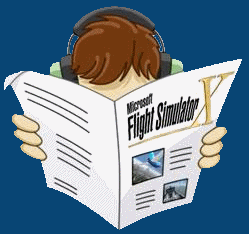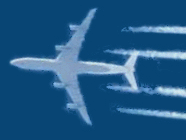|
|
Hover the mouse over the
Runway Designator numbers so
you can see the associated compass headings
[Firefox required]
FAA Air Traffic Plans & Publications
Lots of good study information for understanding things on a deeper
level.
|
Airport Guides
Comprehensive database of US/Can/Int'l airport facilities. Search
using zip code, city, state, airport identifier, identifier list, or airport
name. Easily find specific information including airport diagrams
suitable printing, fuel availability, MagVar, Elevation, Control Tower,
Landing Fees, and full location particulars.
Simviation
Download without having to sign up or join.
Speed/slot restrictions
but the trade-off is fair.
World of AI
Info and
files that bring typical name brand traffic to your airports
and AI traffic.

|
|
WORD ORIGIN - KNOTS
Ever wonder where the speed term "knots" came from?
The earliest legend explanation goes something like this - a rope would have knots tied into it
and be
tossed overboard to drag behind a boat. I suppose at
low speeds most of the knots would sink below sea level and out of sight, but
at high speeds more knots would skim the surface and be visible. I just adore
word origins, but this really fits in as well because so many aviation and
general navigational terms are borrowed from the nautical world.
NASA EDUCATIONAL MATERIALS
Incredible amount of material really for any age group that explains
complex principles in ways that truly make them easier to understand
than the same data I've ever seen presently differently elsewhere.
If you want to learn about avionics, this is a must see site.
Lots of interactive material is to be found at
NASA Virtual Skies.
|
|
AirNav
More detailed charts and diagrams for more situations in and out of
US Airports, as well as NavAids, Fixes and fuel information.
Very nice interface on the website makes it easy to use this
fast server.INSTRUMENT LANDING SYSTEM (ILS)
An aircraft on an instrument landing approach has a cockpit with
computerized instrument landing equipment that receives and interprets
signals being sent from strategically placed stations on the ground near the
runway. This system includes a "Localizer" beam that uses the VOR indicator
with only one radial aligned with the runway. The Localizer beam's width is
from 3° to 6°. It also uses a second beam called a "glide slope" beam that
gives vertical information to the pilot. The glide slope is usually 3° wide
with a height of 1.4°. A horizontal needle on the VOR/ILS head indicates the
aircraft's vertical position. Three marker beacons (outer, middle and inner)
are located in front of the landing runway and indicate their distances from
the runway threshold. The Outer Marker (OM) is 4 to 7 miles from the runway.
The Middle Marker (MM) is located about 3,000 feet from the landing
threshold, and the Inner Marker (IM) is located between the middle marker
and the runway threshold where the landing aircraft would be 100 feet above
the runway.
The VOR indicator for an ILS system uses a horizontal needle in addition to
the vertical needle. When the appropriate ILS frequency is entered into the
navigation radio, the horizontal needle indicates where the aircraft is in
relation to the glide slope. If the needle is above the center mark on the
dial, the aircraft is below the glide slope. If the needle is below the
center mark on the dial, the aircraft is above the glide slope.
|
|
 |
FS
Insider
News, events, information,
developer blogs, screenshots,
mission rundowns... all sorts
of good and fun info.
FSX Missions |
|
GameSpot Reviews |
Flight Simulator X
FSX addon Acceleration
Flight Simulator 2002 |
8.4
8.5
9.3 |
Airport Codes
- FAA codes are assigned by the Federal Aviation Administration to
airports within the United States, US possessions & territories. FAA
codes for airports with scheduled airline operations consist of three
letters. Other FAA airport codes consist of three or four alphanumeric
characters.
- IATA codes contain three letters and
are assigned by the International Air
Transport Association to airports around the world. For US airports
with an IATA code, the code is the same as the FAA code. However,
a US
airport which does not have an IATA code may have a three letter FAA
code which is the same as the IATA code for a non-US airport. (Example
CBG)
- ICAO codes consist of four letters and
are assigned by the International Civil
Aviation Organization, to airports worldwide.
|
|
 |





































